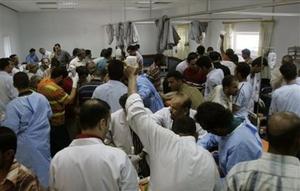Utah implements harsh triage guidelines for bioterror, epidemic emergencies
Utah’s new triage health emergency guidelines would see some children and some seniors turned away from hospitals during a bioterror or epidemic emergency; those who are severely burned, have incurable and spreading cancer, fatal genetic diseases, end-stage multiple sclerosis, or severe dementia will be turned away; people older than 85 also would not be admitted in the worst pandemic; those who have signed “do not resuscitate” orders could be denied a bed

Bioterror or pandemic condition may cause many critically ill patients to be denied medical attention // Source: daylife.com
When a killer flu strikes, with several thousand sick or injured and no room to spare in understaffed hospitals, care will be denied to the sickest adults and children. Those who are severely burned, have incurable and spreading cancer, fatal genetic diseases, end-stage multiple sclerosis, or severe dementia will be turned away. They can be sent elsewhere for comfort care, such as painkillers, but they will not be treated for the flu, according to controversial Utah triage guidelines being modeled across the country.
People older than 85 also would not be admitted in the worst pandemic. Those who have signed “do not resuscitate” orders could be denied a bed. Doctors could remove ventilators from patients deemed unlikely to recover, to give them to other patients.
The Salt Lake Tribune’s Heather May writes that these triage guidelines envision an outbreak — or another public health emergency — so severe that the health care system is unrecognizable. They apply to disasters from bioterrorism to an earthquake.
Developed by the Utah Hospitals and Health Systems Association for the Utah Department of Health, they aren’t mandatory and rely on physician judgment. “The choice is: When you don’t have enough, who do you do it for?” said state epidemiologist Robert Rolfs, who joined hospital medical officers, nurses, emergency doctors and an ethicist who wrote the recommendations. Their answer: Provide the greatest good for the greatest number. Priority will be given to patients who will most likely recover with treatment. People likely to die even with treatment, or likely to survive without it, will not get care.
Largely finalized in January, the guidelines were required as part of the Governor’s Taskforce for Pandemic Influenza Preparedness, created by then-Governor Jon Huntsman Jr. in 2006.
May writes that a group convened by the hospital association spent years studying how others allocated scarce resources, including during a severe acute respiratory syndrome outbreak in Toronto in 2003, said Deb Wynkoop, its director of health policy. She said more than a dozen states have adopted some or all of Utah’s guidelines.
The state could have decided to provide care on a first-come, first-serve basis or use a lottery, said medical ethicist Jay Jacobson, a workgroup member. Instead, it used a wartime triage model. “It was difficult grappling with the idea we would say no for any reason,” he said.
The recommendations would have been implemented if the H1N1 outbreak in Utah had escalated, Wynkoop said. In the
